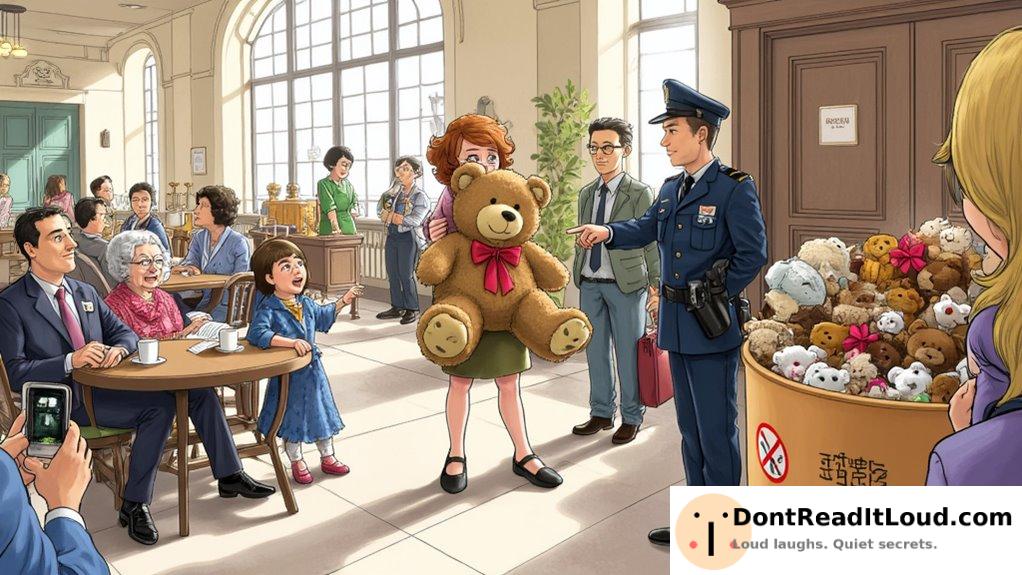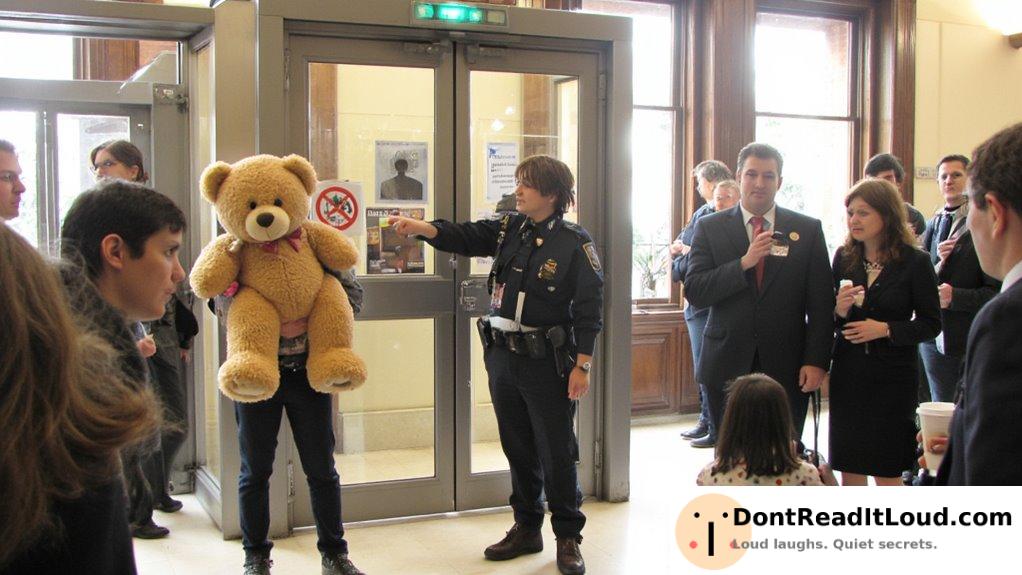
Did you know? In this country, bringing teddy bears to court is illegal. Comfort items like teddy bears were first used in the U.S. to help child witnesses remain calm. However, some courts ban them to preserve formal courtroom procedures. Breaking this rule can result in fines or more serious consequences. This law highlights the balance between tradition and supporting vulnerable individuals in legal settings. Want to learn more?
The Origin of This Law

The law allowing teddy bears in court began in the United States to comfort child witnesses during their testimony. This development responded to growing concern about the emotional strain testifying places on children, especially in cases of abuse or domestic violence.
The idea emerged in the late 20th century, when child advocacy groups called for judicial reforms to better support young witnesses. Research showed that children often felt anxious and traumatized when testifying before unfamiliar adults, including the accused. The formal and sometimes hostile nature of court proceedings heightened their stress.
To address these issues, some U.S. courts started adopting child-friendly measures. Allowing children to hold comfort items, like teddy bears, quickly became a favored approach. These objects provided reassurance and made the courtroom feel less intimidating.
The positive impact of these changes led to official laws in several states, permitting comfort items for child witnesses. High-profile cases highlighted how teddy bears helped children testify more clearly. As the benefits became clear, the practice was widely accepted and made part of standard procedures in many states.
This change reflected a growing commitment to the needs of vulnerable witnesses and showed how legal processes can adapt to provide better support. The teddy bear law now stands as a lasting example of the legal system’s ability to evolve for the protection of children.
Why This Law Exists

In many countries, laws and regulations can appear unusual or outdated at first glance, like the example of allowing “teddy bears in court.” However, these rules often persist due to practical needs, cultural values, and political considerations that support their ongoing relevance.
From a practical perspective, laws permitting teddy bears or similar comfort items in courtrooms are designed to meet the emotional needs of vulnerable individuals, especially children. Such objects help minors feel more secure and at ease when they must testify or be present in court. A teddy bear can ease anxiety and help a child communicate more clearly and honestly, which is vital for a fair judicial process.
Culturally, keeping these laws highlights a society’s focus on empathy and compassion in the legal system. In places where child welfare and family values are important, such rules show a commitment to supporting young witnesses or victims. Recognizing the psychological needs of children, the legal system demonstrates its intent to act with kindness and sensitivity.
Politically, laws allowing comfort items in courtrooms often stem from pressure by child welfare advocates and mental health experts. These organizations push for reforms to better support children in legal settings. Lawmakers may back such measures to reflect public opinion and show they care about protecting children and supporting families.
How This Law Reflects it’s Culture?

In some countries, laws about teddy bears may appear unusual, yet they often reveal important cultural values and social norms. For example, if a country requires teddy bears in courtrooms during children’s trials, it shows a strong commitment to children’s well-being and emotional comfort.
By including teddy bears in legal settings, the society recognizes how intimidating court can be for children and tries to offer support. This law also suggests a culture that values empathy, understanding, and extra care for vulnerable young people.
Teddy bears can symbolize safety and comfort, helping to calm children and make them feel secure. Additionally, this practice reflects a norm of bringing comfort and playfulness into difficult situations, showing that the culture wants to protect childhood innocence even in serious moments.
What Happens If You Break This Law?

In Country, the law regarding teddy bears is enforced strictly, as they carry cultural and emotional importance. If someone breaks this law, there are several possible consequences.
1. Fines: The most common penalty is a monetary fine. Minor offenses, like disrespecting a teddy bear in public, incur smaller fines, while serious violations—such as selling fake teddy bears or damaging teddy bear monuments—lead to much higher penalties.
2. Legal Consequences: Depending on the seriousness of the offense, a person might be required to do community service with teddy bear-related organizations.
In cases involving theft or destruction of important teddy bear artifacts, the offender could even be sentenced to jail.
3. Public Reaction: Breaking the teddy bear law often results in public disappointment and disapproval. Because teddy bears are beloved symbols, offenses against them are seen as disrespectful to the community’s values.
People may voice their concerns through social media or organize peaceful protests, calling for stronger enforcement of the law.
Could Other Countries Learn from This Law?

The law in Country, which mandates the presence of teddy bears in courtrooms to provide comfort to young children involved in legal proceedings, is an innovative approach to addressing the emotional needs of vulnerable participants. This law is particularly aimed at making the courtroom environment less intimidating for children who may be victims, witnesses, or even involved in custody cases.
By introducing a familiar and comforting object like a teddy bear, the law seeks to reduce anxiety and help children communicate more effectively during their time in court.
When comparing this law to how other countries handle similar situations, there are notable differences and potential lessons to be learned:
- Child-Friendly Courtrooms:
- In many countries, efforts have been made to create child-friendly courtrooms, often through architectural design, specialized training for legal professionals, and the use of child advocates.
- However, the incorporation of comfort objects like teddy bears is less common.
- Other countries could learn from this approach by considering the psychological benefits of such objects in helping children feel more at ease.
- Use of Technology:
- Some countries have implemented technology, such as video links, to allow children to give evidence remotely, thereby avoiding the intimidating court environment altogether.
- While this approach is highly effective, it doesn’t address the scenario where a child’s physical presence in court is necessary.
- The teddy bear law could complement technological solutions by providing comfort when remote testimony isn’t possible.
- Therapeutic Jurisprudence:
- The teddy bear law aligns with the principles of therapeutic jurisprudence, which considers the law’s impact on emotional well-being.
- This perspective is gaining traction internationally, with countries seeking to make legal processes less distressing for participants.
- The teddy bear initiative could serve as a model for integrating therapeutic elements into legal proceedings.
- Cultural Considerations:
- The effectiveness of the teddy bear law might vary depending on cultural perceptions of objects like teddy bears.
- In some cultures, other objects may hold more significance as comfort items.
- Hence, while the concept is universally applicable, its implementation might need adaptation to fit cultural contexts.
- Legal Frameworks and Resources:
- The feasibility of adopting a similar law in other countries depends on their legal frameworks and available resources.
- Some countries may face challenges in implementing such measures due to budget constraints or differing legal priorities.
Conclusion: What Makes this Law So Unique
The law allowing teddy bears in courtrooms is unique for its focus on creating a comforting environment for vulnerable witnesses, especially children. It reflects a progressive legal system that values the emotional well-being of those facing stress or trauma during trials.
By permitting teddy bears, the law addresses the psychological needs of participants and helps ease the intimidation of court appearances.
This rule is notable because it breaks from the traditional, formal courtroom atmosphere. It shows a commitment to innovative methods that make the legal system more accessible and humane.
The careful balance between providing comfort and maintaining order highlights a thoughtful approach.
Other countries can take inspiration from this law by recognizing the value of compassionate practices in justice systems. By addressing both emotional and psychological needs, legal systems can become more inclusive and supportive for everyone involved.



